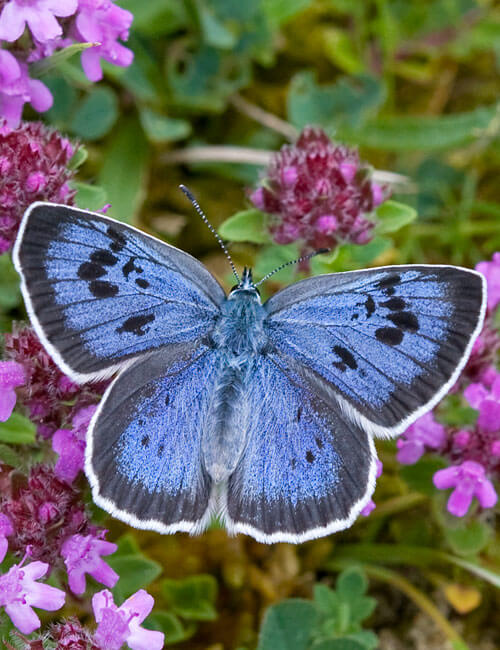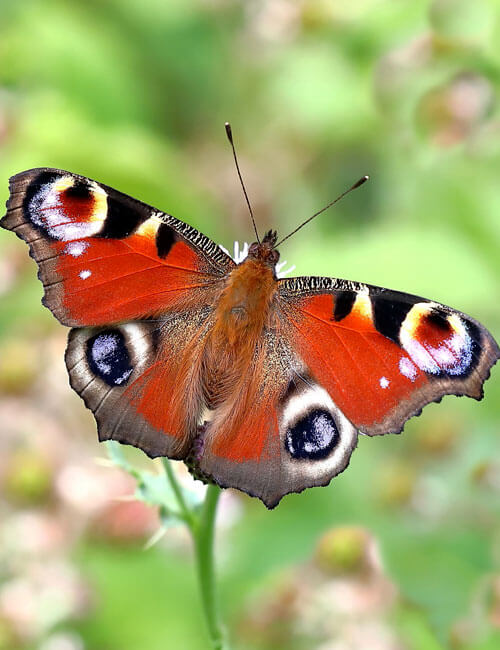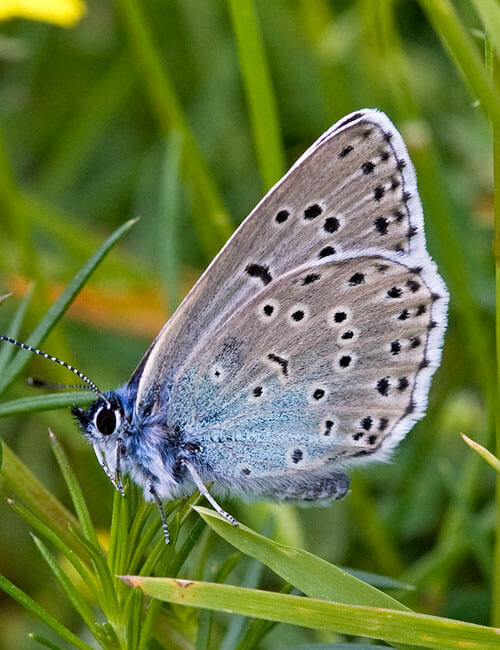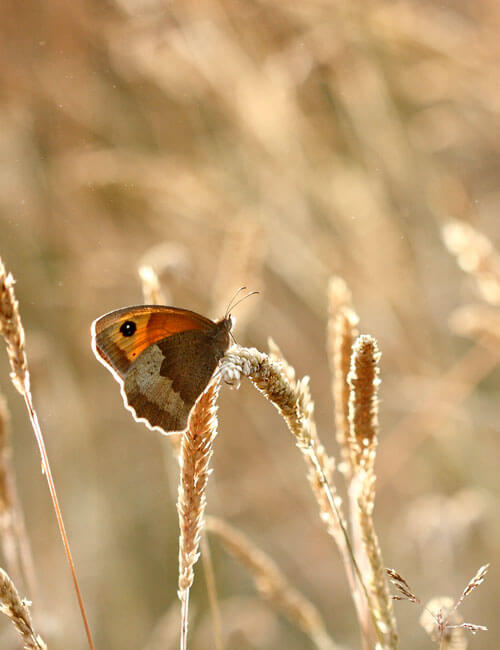Protecting Wilderness Is Protecting Its Inhabitants
Butterflies – Q&A with UK Charity, Butterfly Conservation
Behind every wilderness area hides many interdependent species that are part of a vast variety of ecosystems. Each of these species contributes important and vital elements to their landscape. Protecting wilderness is about protecting each of these species.

Welcome to our series: Protecting wilderness is protecting its inhabitants.
We’re taking you on an exploration of the different species that hide within wilderness areas and that are crucial to the health of Earth’s natural world.
For our second conversation in this series, we asked Butterfly Conservation, a UK Charity on a mission to save butterflies, moths and our environment.
Where do butterflies originate from? Can you share a brief explanation of their history?
Moths and butterflies form the enormous group of insects called Lepidoptera. The earliest Lepidoptera seem to have evolved about 300 million years ago. Butterflies are a relatively small group within the Lepidoptera (i.e. there are far more moth species than butterfly species).
The first butterflies are thought to have evolved around 100 million years ago from moth ancestors. In the family tree of the current Lepidoptera (i.e all those that haven’t gone extinct), butterflies fall in the middle – they are probably more closely related to some of the micro-moth families than the larger and more familiar groups of moths.
Are butterflies suffering from the biodiversity and climate crises?
Yes absolutely. In the UK, for example, where we have very good data on how butterflies have fared since the 1970s, 80% of butterflies have declined in population or distribution (or both). As indicators to a healthy environment, the sharp decline in butterflies shows us the huge scale of biodiversity loss that has happened already and that continues as a direct result of human activity destroying and degrading habitats.
The climate crisis is most seriously affecting butterfly species that are adapted to cooler climates such as those that live on high mountains. We also expect butterflies in the tropics, where their highest diversity occurs, to be particularly badly impacted by climate change. Patterns of climate and weather are shifting unpredictably as a result of climate change. In the UK, ¼ of butterflies have spread north as part of a major change in butterfly distributions that is happening across Europe. However, this pace of change is not keeping up with the warming climate, and many butterfly species simply have nowhere to go having becoming isolated in small fragments of habitat.
Some species are also worse affected if they rely on a particular habitat, and these are the species that have more dramatic declines in the UK. Due to this habitat loss, certain populations are more vulnerable to climate change.
Why is it essential to protect wilderness in order to protect butterflies? And why is it essential to protect butterflies in order to protect wilderness?

Wilderness areas often support a rich diversity of butterflies and other wildlife. Modern farming and forestry practices and urbanisation greatly reduce butterfly populations. Without wilderness only a small proportion of butterflies, the generalists, will survive. As indicators of biodiversity, butterflies provide a warning to us about the health of our environment. Humans fundamentally rely on biodiversity for our survival – for clean air and water, and for food. By protecting our wilderness with appropriate land management, fighting against climate change, and not using pesticides and harmful chemicals we can then protect butterflies and moths.
Butterflies and moths also play a vital role in the food chain. Without them, birds, bats and animals that feed on insects would go hungry and die out, which then has a further knock-on effect for the species that feed on them and the roles they themselves play in the ecosystem. In order to have a healthy wilderness, therefore, we need to protect butterflies.
Butterflies also have huge cultural and symbolic significance to human societies across the world. Generally speaking, people love butterflies which means that they can be used as flagship species to help conserve habitats and whole communities of less well-known or less well-liked creatures.
Does humanity depend on butterflies?
Butterflies and moths both help pollinate our gardens. They help pollinate fruits, vegetables and flowers to produce new seeds. Additionally, butterflies and moths are a vital part of our ecosystem as part of the food chain – which we as humans are part of too.
Butterflies have also been an extremely important group of organisms that have been studied to understand the world around us. They have played a key role in biological research which has contributed to a range of areas from evolution, genetics, population dynamics to embryology.
However, regardless of our reliance on butterflies and moths, they have an intrinsic worth as beings themselves. They have been around for around 100 million years – far far longer than human beings!
In the UK, 80% of butterflies have declined in distribution or abundance since the 1970s. At times like these we might consider what we can do to help them, rather than what we depend on.
Is butterfly conservation paying off? (can you share with us a positive story about this? Feel free to also dive into some of the struggles you commonly face.)

Yes. While the State of the UK’s Butterflies 2022 report highlighted the steep declines in butterflies, it also demonstrated how targeted conservation efforts do work. For example, the reintroduction and ongoing conservation of Large Blue is one of the clearest success stories amidst the overall picture of butterfly decline in England. Although it remains rare and a Priority Species, the Red List status of Large Blue has moved from Regionally Extinct through Critically Endangered and, now, Near Threatened over the past 40 years. Reintroductions to two landscapes, the Poldens and Cotswolds, have thrived thanks to enormous efforts by a partnership of scientists and conservation organisations, resulting in a huge 1,883% increase in abundance from 1983-2019.
Butterfly Conservation has a host of conservation projects that our brilliant teams across the UK work on. You can read more about them here.
Do you have a favourite butterfly species? If so, why that species?
A common favourite butterfly for the staff at Butterfly Conservation is the Brimstone. This is a species that emerges in the Spring time and is often one of the first species of the year to be spotted. For many it signifies the coming of Spring and reminds us of the wonderful butterflies we see more of during the summer.
What is your number one tip to someone who’d like to prioritise protecting butterflies?
 The top thing you can do to protect butterflies is taking action to create a haven for butterflies in your own green spaces. Many urbanised and intensively farmed areas have lost much of their original wildlife habitat – in the UK, for example, 98% of wildflower meadows were destroyed during the twentieth century. Such habitat loss has caused severe declines of butterflies and many other species.
The top thing you can do to protect butterflies is taking action to create a haven for butterflies in your own green spaces. Many urbanised and intensively farmed areas have lost much of their original wildlife habitat – in the UK, for example, 98% of wildflower meadows were destroyed during the twentieth century. Such habitat loss has caused severe declines of butterflies and many other species.
But anyone and everyone can take action to transform a space – no matter how big or small – to provide butterflies with a space where they can not only survive but thrive. By creating a Wild Space, you would need to steer clear from pesticides and peat in order to make a butterfly-friendly space, whether it’s a flowerpot on your balcony, or planting wildflower seeds in your garden.
Learn more about Butterfly Conservation: https://butterfly-conservation.org/ or Instagram
Did you enjoy this first conversation of the series? Let us know in the comments if there are any particular subject matters you would like us to discuss.
Please release more updates.
Hi Diana! Thank you for your interest. We encourage you to follow or reach out to Butterfly Conservation (https://butterfly-conservation.org/) for more updates on their work.
Hi it was on the news this morning that to protect butterflies we need to avoid cutting grass between April and sep? I presume this is correct, and if so I would highly recommend you reach out to different woodland companies to encourage them to not cut their grass. Local places to me that have large grassland areas are Rufford country park, Newstead Abbey, Renishaw hall, Hardwick hall (national trust), Ulley country park (rotherham council), and Graves Park (Sheffield council). Hopefully you can convince these places to support butterflies!